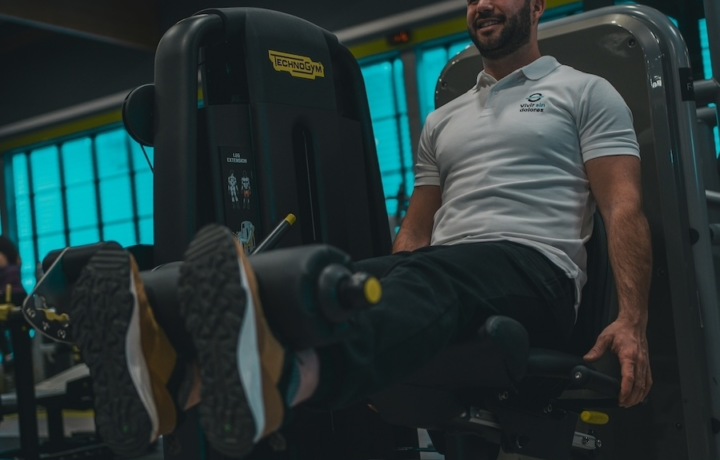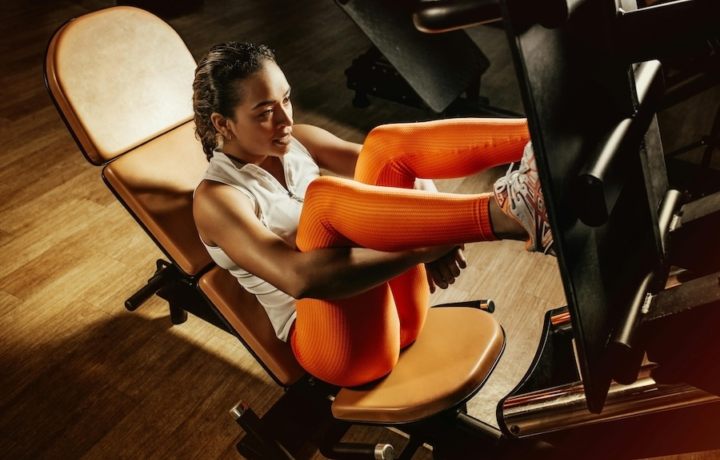Exercise
Barbell Lunge

Barbell Lunge
How to Perform
- Position the barbell across your upper back, resting it on your trapezius muscles with your hands gripping the bar slightly wider than shoulder-width apart.
- Stand with your feet hip-width apart, core engaged, and chest lifted to maintain a neutral spine throughout the movement.
- Take a controlled step forward with your right foot, creating a stride long enough that when you lower, both knees will form 90-degree angles.
- Inhale as you begin to descend, bending both knees simultaneously while keeping your torso upright and shoulders pulled back.
- Lower until your back knee hovers just above the floor and your front thigh is parallel to the ground, ensuring your front knee stays aligned over your ankle, not pushing beyond your toes.
- Push through the heel of your front foot as you exhale, driving yourself back to the starting position with controlled force.
- Maintain tension in your core and glutes throughout the entire movement to stabilize your spine and pelvis.
- Complete all repetitions with one leg before switching to the other side, or alternate legs for each repetition depending on your program design.
Important information
- Keep your upper back tight and chest up throughout the movement to prevent the barbell from rolling forward and compromising your posture.
- Make sure your front knee tracks in line with your toes and doesn't collapse inward, which can place stress on the knee joint.
- Start with lighter weight until you develop proper balance and coordination, then gradually increase the load as your technique improves.
- If you experience knee pain, try adjusting your stride length or consider using a split-stance variation instead of the full lunge.

Barbell Lunge
Exercise Details
Primary Muscles
Muscle Groups
Mechanic
Risk Areas
Built for progress
Take the guesswork out of training
Create personalized AI-powered workout plans that evolve with you. Train smarter, track every rep and keep moving forward, one workout at a time.






The barbell lunge stands as a cornerstone exercise in strength training arsenals, delivering impressive results for those ready to advance beyond beginner movements. This compound exercise simultaneously targets multiple lower body muscle groups, with primary emphasis on the glutes, quads, and hamstrings. What makes the barbell lunge particularly effective is its ability to challenge each leg independently while maintaining the stability demands of supporting a loaded barbell.
For bodybuilding enthusiasts, the barbell lunge offers exceptional muscle development potential through controlled execution and progressive overload. The exercise creates significant mechanical tension in the target muscles, stimulating hypertrophy when performed with appropriate resistance. Meanwhile, HIIT practitioners appreciate how barbell lunges can elevate heart rate quickly when incorporated into high-intensity circuits, making them versatile for both strength and conditioning goals.
The beauty of the barbell lunge lies in its functional carryover to everyday movements and athletic performance. The unilateral nature of lunges addresses muscle imbalances between legs while enhancing core stability and proprioception. Many athletes report improved performance in sports requiring explosive lower body power after incorporating weighted lunges into their training regimens.
From a strength development perspective, barbell lunges create a powerful stimulus for adaptation. The exercise activates a substantial amount of muscle tissue, triggering hormonal responses favorable for overall strength gains. As an intermediate-level movement, it bridges the gap between basic bodyweight exercises and more advanced lifting techniques, allowing for continued progression without plateauing.
While not as commonly tracked as squats or deadlifts, many serious lifters find that improving their lunge numbers correlates with enhanced performance across other compound lifts. The exercise demands not just raw strength but also coordination, balance, and mental focus—qualities that define the intermediate lifter. When programmed appropriately with progressive overload principles, barbell lunges become an invaluable tool for developing lower body power, functional mobility, and aesthetic development.
FAQ - Barbell Lunge
Barbell lunges primarily target the quadriceps, hamstrings, and glutes, with significant engagement of the calves and core muscles for stabilization. The exercise is particularly effective for developing the glute medius, which is crucial for hip stability and preventing knee issues.
Keep your torso upright, core braced, and ensure your front knee tracks in line with your toes without extending past them. Step forward far enough that your back knee can lower toward the floor without touching it, creating two 90-degree angles with both legs at the bottom position.
Beginners should start with bodyweight lunges before progressing to a light barbell or even an empty bar. Advanced lifters can increase weight progressively, try deficit lunges (stepping off a platform), or incorporate tempo work with 3-4 second lowering phases to increase time under tension.
Include barbell lunges 1-2 times weekly, allowing 48-72 hours of recovery between sessions that target the same muscle groups. They work well as a primary exercise on leg day or as an accessory movement after squats or deadlifts when your stabilizing muscles aren't completely fatigued.
Avoid leaning your torso too far forward, allowing your front knee to collapse inward, or taking steps that are too short. Also, don't rush through repetitions or use momentum to power the movement – controlled execution with proper weight selection will maximize results while minimizing injury risk.








